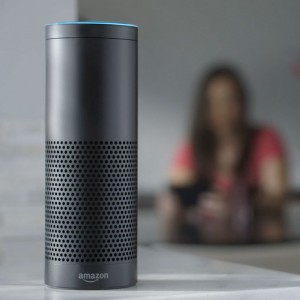How Virtual Voice Assistants Can Extend the Reach of Your Healthcare System
// By Lisa D. Ellis //
 Imagine if all of your older and chronically ill patients had personal assistants to help them monitor their vital signs, answer pressing health questions, and remind them to take their medicines. While this scenario may sound ideal, it’s also quite an unrealistic goal to expect to accomplish for an entire population. But the newest generation of voice-activated virtual assistants, or personal intelligence agents, may be able to fill a similar niche in a timely and cost-effective manner using a software program that can be tailored for different situations.
Imagine if all of your older and chronically ill patients had personal assistants to help them monitor their vital signs, answer pressing health questions, and remind them to take their medicines. While this scenario may sound ideal, it’s also quite an unrealistic goal to expect to accomplish for an entire population. But the newest generation of voice-activated virtual assistants, or personal intelligence agents, may be able to fill a similar niche in a timely and cost-effective manner using a software program that can be tailored for different situations.
Tapping Into a Growing Trend
There’s been growing popularity of voice devices and intelligent assistants like Amazon’s Echo and Alexa, Google’s Home, and Apple’s Siri, which all work in a similar way to provide voice-activated responses to general requests for information. There’s also been an explosion in the personal sensor field, with a host of fitness trackers and other wearable devices on the market today that can measure things like activity levels, pulse, and blood pressure. Therefore, it should come as no surprise that the health sector is now getting into the game by extending the reach of these tools in innovative ways.
In fact, these capabilities, coupled with the emphasis on population health, has prompted a growing number of companies to turn the existing devices into automated “case managers.” As such, these tools can help increase patients’ engagement in their own health and can hopefully also help them head off any serious complications.

Nathan Treloar, president of Orbita Inc.
“A digital voice assistant will never replace the human touch, but it can capture information strategically to help guide decision-making and care,” says Nathan Treloar, president of Orbita Inc., a company that operates in the digital home health care, care coordination, and virtual assistant space.
He points out that his company’s cloud-based software-as-a-service (SaaS) solution, called Orbita Engage, is a home health platform that integrates data from the various wearable, health, and voice devices. It then provides solutions for patients, in-home caregivers, clinicians, and family members to streamline care coordination and management across various disease states. Using the company’s more recently released Orbita Voice software, healthcare organizations can capture voice and other data, and tailor response trees to create iterative conversations based upon individual patient responses.
With the growing focus on providing high-quality, cost-effective, patient-centered care, virtual voice-activated assistants offer a convenient way to increase patient satisfaction and drive better outcomes.
To this end, Orbita Voice works with the latest wearables and sensors (like activity trackers and blood pressure cuffs connected to the internet) so they can track key health measures such as temperature, blood sugar, blood pressure, medication adherence, and more.
“We enable care providers to create voice surveys and reminders for patients, and put it all in a casual tone that flows like a natural conversation,” says Beth Strohbusch, public relations director for Orbita Health.

Beth Strohbusch, public relations director at Orbita Health
She explains that health systems can capture and store a wide array of information from voice-activated assistants and other connected devices. Analytics can be applied and information can be presented to a patient’s case manager, for example, who can see patterns, be alerted to potential crises, and, ideally, head off serious complications to reduce the risks of hospitalization or health decline.
Managing the Data
Treloar points out that some organizations use Orbita Voice software and the Orbita Engage platform together to streamline the process of automating their key measures and outcomes. The solution makes it easy for healthcare providers to see broader health and population patterns.
Further, the platform can be plugged into the organization’s electronic medical health records, painting a clearer picture of each person’s health status, issues, and overall situations. Other organizations with established care management platforms may prefer to voice-enable their environments by plugging Orbita Voice into their network.
The most important thing either way, according to Treloar, is finding ways to use the information for the benefit of the health systems and their patients.
“The healthcare sector doesn’t need more data. It needs a better way to analyze the data that exists and make it meaningful and actionable,” he says, adding that this is an important goal driving Orbita’s efforts.
Putting Voice-Activated Personal Assistants to Use
While its efforts are still in the early stages, Treloar points to a new collaboration between Orbita and the Commonwealth Care Alliance (CCA) in Massachusetts, which serves low-income patients with complex diagnoses.
As part of a pilot program funded by the Center for Health Care Strategies (CHCS), 100 CCA members will use an Amazon Echo device to manage communication and coordination with their personal care attendants, which are an important part of their care plans. Under the CCA model, the members hire, schedule, and pay for their PCAs themselves, which can be time intensive and stressful.
The hope is that using Orbita’s technology will help members to better navigate this challenging territory, keeping track of appointments for them, and also providing reminders in advance of the PCA visits. All of the members are being trained by CCA staff on how to use the software properly, and CCA will monitor their progress, which will be measured through focus groups and surveys, as well as member utilization rates, voice interaction errors, costs, and the time commitment required for people to use the voice-activated system. In addition, Treloar says the virtual-assistance capability will help to head off unnecessary emergency visits by providing patients with the tools they need to better navigate their health and various issues and situations.
“This is a way to engage patients and try to make the process more efficient for them,” Treloar says.
Another Orbita customer, this one in California, is an assisted-living facility using Orbita Voice to connect with residents and answer their questions, taking some of the stress off the facility’s care manager, who can be inundated with calls and requests for information from patients. Treloar says much of the information can be provided seamlessly by the voice system.
Hope for the Future
Other uses of Orbita Voice software (and of other similar offerings on the market today) include reducing isolation for aging folks, as well as being part of a comprehensive strategy to manage the care of people with dementia, since the virtual assistant won’t mind answering the same question again and again, if needed.
If Orbita’s early efforts are a good indicator, in the future, they—and other companies in the virtual-assistant space—will hopefully be able to use technology to minimize the burden on the healthcare system while empowering patients to be more involved in their own care journey.
A Sample Patient/Virtual-Assistant Conversation
Treloar offers this example of how a voice-activated assistant would “converse” with a patient and respond to the information gathered:
Let’s say there’s someone with chronic pain and she calls her virtual, voice-activated assistant Sally. The patient wakes up and says, “Good morning, Sally.”
Sally replies, “Good morning. Today is Wednesday, June 22. How are you feeling today? What is your pain level?”
The patient says that her pain is a 5.
“A 5 is good since your pain was an 8 yesterday,” Sally replies, going on to remind the patient to take her morning medicines and that a home health care worker will be stopping by in the afternoon.
On the other hand, if the patient says that her pain is a 10, Sally will ask some key questions, such as how the patient slept, if she fell, and when she last took her pain medicine.
When the responses indicate something could be wrong, the system can be used to send a trigger for a case manager to call the patient or have the patient come in to be seen by a clinician.
Another example is if the patient is diabetic and her blood sugar reading was high. Sally asks the patient to test the blood sugar again in a designated time frame. If the reading continued to climb, this triggers an alert for a health care provider to respond immediately and perhaps send a text to the family, too, to alert them of the urgent situation.
Such an approach is helping patients with chronic conditions manage their medical needs more effectively from the comfort of their own homes.
Lisa Ellis is editor of Strategic Health Care Marketing, the sibling publication of eHealthcare Strategy & Trends. She is a journalist and content development specialist who helps hospitals and other health care providers and organizations shape strategic messages and communicate them to their target audiences. You can reach her at editor@strategicHCmarketing.com.
Related Articles
What Is the Role of a Marketing Technologist?
Ten Hacks for Keeping at the Top of Your Marketing Game
Health Systems Put Machine Learning to Work to Increase Efficiency and Improve Outcomes
Can Smartphones Help Patients with Behavioral Health Disorders
Virtual Assistants Become the Newest Members of the Healthcare Team

